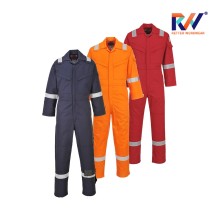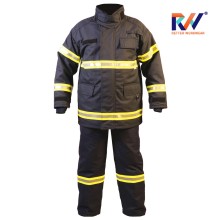How Are Fire Suit Manufacturers Responding to Industry Changes
- By: Admin
- Apr 15, 2025

In the continuously changing landscape of workplace safety, fire suit makers are entering a new age of innovation. The conventional method of flame resistant apparel has changed dramatically in the last decade, as increasing demands from industries like oil and gas, utilities, aviation, and chemical manufacturing have been made. These industries are no longer content with minimal protection now they demand high performance suits designed by Fire Suit Manufacturers such as Retter Workwear that integrate superior safety features with flexibility, comfort, and regulatory compliance. Manufacturers are now reacting to these changing industries with intelligent materials, quick production cycles, and specialized equipment designed specifically to address the new needs of contemporary workers.
Advancing Fabric Technology for Greater Protection
One of the major revolutions in fire suit production had been the advancement in fabric technology. Modern day fire suits are no more, hot, stiff, or uncomfortable. Rather, lighter yet tougher materials with breathability and comfort are used today, so that fire suits can perform in extreme situations without putting any weight on workers. Such innovation is indispensable in industries with long working hours and harsh conditions. Suit producers are looking for materials that provide not just flame resistance but also arc flash, chemical, and molten metal splatter protection. Several Arc Flash Clothing Manufacturers have driven this change by creating products that shield against high energy electrical dangers. Their research has driven the design of fire suits that provide double protection: thermal and electrical.
Customization to Meet Industry Specific Needs
Each worksite has its own risks, and manufacturers of fire suits have realized that one size fits all just doesn't apply anymore. Customization is the big trend these days. Manufacturers are collaborating with companies to create suits tailored to particular risks petrochemical spills, confined space dangers, or wildland firefighting, to name a few. This way, the suit not only guards but also facilitates greater mobility and productivity for the wearer. Fire suit customization also covers climate and environmental conditions. For instance, companies now make suits with built in cooling layers or thermal insulation based on the working environment. Different types of protective features are required in cold climates as compared to those required by companies operating in the hotter temperatures of desert oilfields.
Intelligent Integration of High Performance Materials
Whereas conventional fire suits used to be constructed using plain treated cotton or wool mix, today's manufacturers are using high performance fibers such as Kevlar, PBI, and Nomex. These fibers not only resist heat but also retain their integrity after repeated washing, extensive exposure, and physical wear and tear. Of all these, Nomex continues to be one of the most trusted and most commonly used flame resistant fabrics in the market. Many Nomex Coverall Manufacturers specifically have been at the forefront of creating lightweight but potent clothing that provides full body protection without compromising comfort. Their coveralls are frequently utilized in aviation, refinery work, and emergency response teams because of their superior flame and abrasion resistance.
Adopting Eco Friendly Manufacturing Practices
Not only shift for safety regulation in the industry but they often also extend for sustainability targets. Manufacturers are going green and answer the world call for sustainable manufacturing. They employ recycled fiber, reduce volume of water and chemicals in the dyeing processes, and discover more environmental friendly methods into their production. Digital cutting systems use to reduce material waste from other manufacturers while some have established closed loop recycling programs for end of life suits. Rather than satisfying the eco aware customer, this goes on to make a much larger commitment to generations of employees to come and to the world at large.
Digital innovation is changing the face of ordering, manufacturing, and shipping processes of fire protective apparel, so that they can be easily managed. Manufacturers are spending on OCR based forecasting, ERP systems, and virtual fitting software to ease these processes. Customers can now configure their equipment online, check it against a timeline of when to expect things, and receive updates on what it will take to finish a project. This seamless flow encourages the realization of trust and transparency.
Both virtual training modules and garment use guides are being rolled out to train teams on the proper use, storage, and care of fire resistant garments this training goes a long way toward learning safety procedures and reinforcing those procedures thus keeping every garment value added over time. As the needs of industrial environments become increasingly complex, these manufacturers are meeting them with flexibility, innovation, and intent.
How Do Fire Retardant Coverall Manufacturers Keep Up with Technology
FR coverall manufacturers like Retter Workwear are innovating with smart fabrics, custom fits, and automation, delivering advanced, comfortable, and high performance fire resistant clothing for demand...
Posted by: Admin
How Are Fire Suit Manufacturers Responding to Industry Changes
Retter Workwear revolutionizes fire suit manufacturing with advanced materials, industry specific customization, eco friendly production, and digital innovation, ensuring top-tier protection, comfort,...
Posted by: Admin






